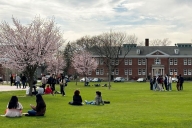You have /5 articles left.
Sign up for a free account or log in.
Michael Bloomberg has rightly attracted attention for donating $1.8 billion to Johns Hopkins University for financial aid for low- and middle-income students, and for ensuring that JHU’s admissions remain “need-blind” for the foreseeable future. It’s a generous gift, obviously, and will almost certainly do far more good than the similar figure New York City is donating to Amazon so Jeff Bezos won’t have to pay for his own helipad. But in reading Bloomberg’s piece about the donation this weekend, something didn’t sit right.
I’ll start with the most obvious point. Bloomberg writes:
“When colleges review applications, all but a few consider a student’s ability to pay.”
Um, no. That’s simply false. Most don’t. In fact, most colleges aren’t selective in any meaningful sense of the word. You’d think that an editor at the newspaper of record would have caught that, but it tends to share the same blind spot. To give an easy example, community colleges are both open-admissions and need-blind, and have been for decades.Even mild selectivity applies only to a fraction of four-year colleges, let alone community colleges.
As Bloomberg’s piece goes on, though, he moves from “colleges” to “top colleges” and “elite colleges,” without acknowledging the shift. Then he shifts back, as in this howler:
“We need to persuade more colleges to increase their financial aid and accept more low- and middle-income students.”
Again, even a quick look at community and state colleges would put the lie to this. These schools don’t need to be persuaded to accept more low-income students; they already do, at high levels. Yes, more aid would help, but that isn’t a matter of persuading the colleges, most of which are making heroic efforts to stretch straitened budgets as far as they’ll go. The limiting factors there are political and structural, and far beyond what a little persuasion or donation will fix.
Bloomberg’s interchangeable use of “colleges” and “elite colleges” is revealing. Consistent with the “lifeboating” literature -- also called “undermatching” -- he’s essentially assuming that only elite colleges matter. The rest are just, well, there. The task for philanthropists and policy types, in this vision of the universe, is to pluck a few more lucky and worthy exceptions from the great unwashed. What happens to the rest is left unaddressed, by design.
None of this is to downplay the merits of JHU, or of helping students who couldn’t otherwise afford it to attend. That’s all good. The point is that most students will never attend “elite” places, by definition. If we want to strike a blow for equity and fairness, diversifying the 50 or so most selective places should be a footnote. The real task would be to bring the colleges that serve the masses -- non-elite publics -- to a level worthy of their students.
Bloomberg shouldn’t have to look far to find examples. CUNY, for instance, has an enviable track record of doing right by first-generation and low-income students. As former mayor of New York City, he should know that. A couple of billion dollars could go a long way at CUNY. Or at SUNY, or at any community college system in the country. He could endow second-year scholarships, for instance, and/or fund the growth of “development” (fundraising) offices among community colleges. He could, if he chose, endow professional development funds for every community college in the country, so faculty could keep in touch with innovations in their fields. And that’s just off the top of my head.
Again, there are worse ways to spend that kind of money (cough Amazon cough). Bloomberg didn’t have to make a generous gift, but he did, and that’s commendable. But as with most philanthropy, it isn’t going where it would do the most good. It’s actually reinforcing a kind of fatalism about the colleges that serve most Americans who go to college. Most colleges aren’t selective, and never will be; it’s time to stop punishing them for that.







